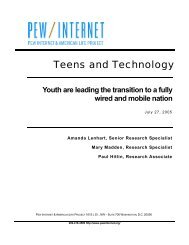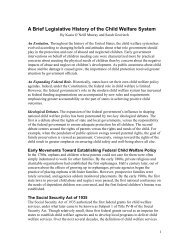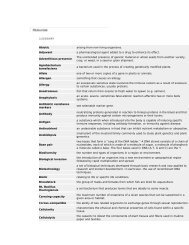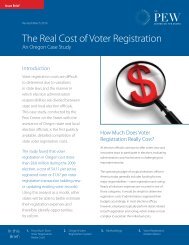Protecting Western Australia's Big Blue Backyard - The Pew ...
Protecting Western Australia's Big Blue Backyard - The Pew ...
Protecting Western Australia's Big Blue Backyard - The Pew ...
You also want an ePaper? Increase the reach of your titles
YUMPU automatically turns print PDFs into web optimized ePapers that Google loves.
RISING TO THE CHALLENGE<br />
Australia’s marine environment is one of the most<br />
important on Earth. As a nation, we are responsible<br />
for almost 16 million square kilometres of the<br />
world’s oceans—twice the area of our land.<br />
Australia has the largest area of coral reefs in<br />
the world as well as the largest single coral reef,<br />
the Great Barrier Reef. Our 4000 fish species<br />
represent 20 per cent of the Earth’s total. Six of<br />
the world’s seven marine turtles are found here,<br />
along with 45 of the 78 known species of whales,<br />
dolphins and porpoises. No other nation has 30<br />
of the globe’s 58 species of seagrass.<br />
Despite its global, national and regional values<br />
of significance, and our international commitment<br />
to sound marine management, less than four per<br />
cent of Australia’s marine environment is highly<br />
protected from extractive uses including fishing<br />
and mining. Moreover, the no-take protection is<br />
mostly in one place—on the Great Barrier Reef.<br />
This is well below today’s international standards<br />
that have been set by the recent establishment<br />
of large no-take areas in the Hawaiian Islands,<br />
Mariana Trench and Kiribati.<br />
Many of the special qualities of Australia’s marine<br />
environment reside in the marine waters off<br />
<strong>Western</strong> Australia.<br />
Australia’s marine environment spans five climate<br />
zones, <strong>Western</strong> Australia’s crosses three. Of the<br />
12,000 islands in Australian waters, 3747 are found<br />
in <strong>Western</strong> Australia’s state waters alone.<br />
Australia’s marine waters have a vast depth range<br />
but the deepest waters, the largest marine canyon,<br />
the highest undersea mountain range and largest<br />
subsea plateau are off the south-west corner of<br />
<strong>Western</strong> Australia between Kalbarri and Eucla.<br />
Three oceans come together in Australia’s marine<br />
environment, two of these, the Indian and the<br />
Southern, merge in that same south-west corner<br />
of the continent.<br />
<strong>The</strong> Kalbarri to Eucla region has important tropical<br />
coral reefs, and internationally significant seagrass<br />
meadows and sheltered inshore lagoons.<br />
Multi-coloured ‘old-growth’ sponge gardens,<br />
rocky reefs and a unique mix of tropical and<br />
temperate species are found here.<br />
Threatened whales, sharks, turtles, seals and<br />
seabirds make the Kalbarri to Eucla region their<br />
home. <strong>The</strong> region also contains Australia’s most<br />
lucrative fishery, the western rock lobster fishery,<br />
as well as the Perth Canyon’s critical feeding area<br />
for the Earth’s largest animal, the endangered<br />
blue whale. It is one of only two known blue whale<br />
feeding areas in Australia.<br />
<strong>The</strong> region is a big part of Australia’s southern<br />
waters where a world-record 70–90 per cent of<br />
fish, seaweeds, molluscs and other marine life are<br />
endemic, found nowhere else on Earth. Moreover,<br />
significant finds of species new to science continue<br />
to be made.<br />
<strong>The</strong> Kalbarri to Eucla region is internationally<br />
significant and critically important to Australia.<br />
It is also of vital importance to the future of<br />
<strong>Western</strong> Australians, with their way of life reliant<br />
on the good health of the region’s marine<br />
environment.<br />
But less than one per cent of the marine waters<br />
from Kalbarri to Eucla is protected, a level that is<br />
the worst off any state in Australia. Most of this<br />
area is under Australian Government control.<br />
<strong>Protecting</strong> <strong>Western</strong> Australia’s big blue backyard<br />
demonstrates the importance of the Kalbarri to<br />
Eucla region—and the current and future threats<br />
to its superlative values—by following the route<br />
of the unique Leeuwin Current as it flows through<br />
the region on its 5500-kilometre journey from<br />
Indonesia to Tasmania. <strong>The</strong> Leeuwin Current has<br />
a profound influence on local climate, marine life<br />
and people and is the main reason for the region’s<br />
global significance.<br />
This report from the Save our Marine Life<br />
Collaboration visits a number of hotspots for<br />
marine life as it follows the Leeuwin Current’s<br />
journey. <strong>The</strong>se include the Houtman-Abrolhos<br />
Islands, the Perth Canyon, Geographe Bay, Cape<br />
Mentelle, the Naturaliste Plateau, the Diamantina<br />
Fracture Zone, the Albany Canyons and the<br />
Recherche Archipelago.<br />
Each of these areas is of great significance and<br />
worthy of protection in its own right. But together,<br />
and combined with other important marine values,<br />
make the case for protection of the region’s marine<br />
environment even stronger.<br />
In <strong>Protecting</strong> <strong>Western</strong> Australia’s big blue backyard<br />
the Save our Marine Life Collaboration is urging<br />
the Australian Government to secure with certainty<br />
the important marine values of the Kalbarri to<br />
Eucla region. It can do this by establishing a<br />
Comprehensive, Adequate and Representative<br />
(CAR) network of large no-take marine reserves.<br />
A Comprehensive network is one in which all<br />
major bioregions have reserves within them.<br />
Adequate refers to the number, size, configuration<br />
and level of protection of the reserves within<br />
a bioregion. <strong>The</strong> reserves also need to be<br />
Representative of the ecosystems within<br />
the bioregions.<br />
This report outlines the many environmental,<br />
social and economic benefits that will flow from<br />
a CAR network of large no-take marine reserves<br />
in <strong>Western</strong> Australia’s big blue backyard.<br />
4<br />
Australia’s marine<br />
environment is one of the<br />
most important on Earth<br />
Threatened southern right whales are<br />
slowly recovering from whaling. A mother<br />
and her calf bask in south-coast waters<br />
warmed by the Leeuwin Current<br />
Andrew Halsall Photography / © DEWHA
















